Overview
- Brief Narrative
- Unused, red inverted triangle badge with the letter E found by Lt. Milton Shurr, a Jewish American soldier, in April-May 1945 at the recently liberated Buchenwald concentration camp in Germany. The red cloth was to identify the inmate as a political prisoner. The letter indicated camp status or nationality. E was used for intellectuals or influential inmates sent to be reformed or re-educated. The patch would be attached on the left breast of the jacket or on the pants leg. First Lt. Shurr assisted in the planning for D-Day, June 6, 1944, and joined the Civil Affairs Unit. He landed on Omaha Beach soon after the invasion to organize medical supplies. He was placed with the 1st Army Displaced Persons Team. On April 11, 1945, the US Third Army liberated Buchenwald. Command of the camp was transferred to the 1st Army, which was responsible for establishing order, improving camp conditions, and caring for the inmates. Shurr worked 16 hour days trying to find enough food for the 15,000 starving survivors at the camp. He was a liaison with the Red Cross and American Jewish Joint Distribution Committee. He later was sent to Bavaria as a health welfare officer to assist with the re-establishment of schools, hospitals, and other social services by the US Military occupation government.
- Date
-
found:
1945 April-1945 May
- Geography
-
found:
Buchenwald (Concentration camp);
Weimar (Thuringia, Germany)
- Credit Line
- United States Holocaust Memorial Museum Collection, Gift of Milton L. Shurr
- Contributor
-
Subject:
Milton L. Shurr
- Biography
-
Milton Shurr was born on January 28, 1911, in Rochester, NY, to Mr and Mrs. Harry Shurr. On June 3, 1941, he married Muriel Friedman, from New York City. That year, motivated by news about the persecution of Jews in Europe, including news from correspondents about the camps, Milton joined the field staff of the Council of Jewish Federations and Welfare Fund. He moved from Minneapolis, MN, to Oklahoma City, OK, to head the Fund. He transitioned from being a program organizer in public health to arranging regional conferences to fundraise and to inform US citizens of what was happening abroad.
The United States entered World War II on December 8, 1941, following the attack on Pearl Harbor. Milton was drafted into the US Army and enrolled in Officer's Candidate School. Corporal Shurr was then sent to military government school to be trained to rebuild postwar Germany. First Lieutenant Shurr and the rest of his class were deployed to Great Britain in February 1944. They assisted in the preparations for Operation Overlord, set for June 6, 1944. He was recruited from the Quartermasters Corp by the Army's Department of Civilian Affairs. Slated to deploy one week after D-Day, their departure was delayed to send more fighting troops. They then landed on Omaha Beach near Isigny. Milton was stationed with the 1st Army. He was assigned to collect medical or other supplies dropped on the beach and then throughout France.
In October 1944, Milton was placed with the 1st Army Displaced Persons Team in Vervier, Belgium, and was in Malmady during the Battle of the Bulge. He continued to travel widely with a driver searching for supplies. They drove through combat territory and were often bombed. Around January 1945, Milton fell ill with hepatitis and was sent to England to recover. He returned to his unit in Germany the day after Patton's 3rd Army liberated Buchenwald concentration camp on April 11, 1945. Buchenwald was then transferred to the command of the 1st Army, which had the task of creating a stable, orderly environment out of the chaotic conditions found at the camp. Camp conditions were in turmoil; soldiers were looting and corpses were piled everywhere. Milton was faced with the enormous task of caring for the approximately 15,000 surviving prisoners, all men and boys, who were dying at a rate of 300 persons a day. Milton met daily with about fifteen capos who were his eyes and ears in the camp and his main source of information about what the former prisoners needed. He was in charge of supplies and worked with a team of three-four officers, six enlisted men, four-five liaison foreign officers, two Russian women who were the cooks, and an assortment of local assistants and mechanics. He worked 16 hour days trying to find enough food to keep the inmates alive. They scoured the surrounding country for supplies and obtained most of their food supplies by confiscating them from German civilians. Cigarettes were used as currency. The Army had obtained nearly a ton of Turkish cigarettes from German supplies. He paid inmates in cigarettes to load and unload trucks. About forty Polish prisoners were recruited to find him transport. They stole two diesel trucks from German locals, and painted them olive drab, with false ordnance numbers.
Milton also assisted with the repatriation efforts. Western Europeans were repatriated first. Eastern Europeans were given the choice of returning home or moving to the West. Milton was a liaison with the Red Cross and the Joint Distribution Committee, who organized the repatriation and resettlement of the survivors. There were about 700-1000 boys in the camp and Milton worked with both groups to get them individualized attention. Most were resettled in Palestine. As prisoners left, they were replaced by new ones who wanted to move West. The camp gradually transformed into a displaced persons camp. Horrified by the lack of the value of life in the camp, Milton tried to preserve and collect evidence of the crimes committed there for military investigators. Milton remained at Buchenwald until July 1, 1945, when the camp was transferred to the Soviets, who turned it back into a prison camp. Milton was reclassified as a health welfare officer, part of the military occupation government. He was stationed in Bavaria, where he worked to reopen schools, hospitals, banks, and other social services. In 1949, Milton declined a permanent position with the military in Bavaria as he wished to return to his wife. After demobilization in New Jersey, Milton and his family relocated to Chicago where he worked in health planning. Milton was unable to speak of Buchenwald for many years. Supported by his wife Muriel’s belief that he had a responsibility to share what he had witnessed, after forty years, Milton began to share his experiences. Milton, age 98, died in 2009. His wife Muriel died a month later.
Physical Details
- Language
- German
- Classification
-
Identifying Artifacts
- Category
-
Badges
- Object Type
-
Prisoner badges (ushmm)
- Physical Description
- Unused, lightweight red cloth inverted triangle patch with the letter E applied in black ink near the top front. The edges are unfinished and frayed.
- Dimensions
- overall: Height: 2.625 inches (6.668 cm) | Width: 2.750 inches (6.985 cm)
- Materials
- overall : cloth, ink
- Inscription
- front, top front, black ink : E [Erziehungshäftlinge, Re-education]
Rights & Restrictions
- Conditions on Access
- No restrictions on access
- Conditions on Use
- No restrictions on use
Keywords & Subjects
- Topical Term
- Holocaust survivors--Germany--Weimar (Thuringia)--Biography. Jewish soldiers--United States--Biography. Reconstruction (1939-1951)--Germany--Personal narratives, American. Soldiers--United States--Biography. World War, 1939-1945--Concentration camps--Liberation--Germany--Weimar (Thuringia)--Personal narratives, American. World War, 1939-1945--Food supply--United States--Biography. World War, 1939-1945--Medical care--United States--Personal narratives. World War, 1939-1945--Personal narratives, American.
- Geographic Name
- World War, 1939-1945--Prisoners and prisons, German.
Administrative Notes
- Legal Status
- Permanent Collection
- Provenance
- The prisoner badge was donated to the United States Holocaust Memorial Museum in 1988 by Milton L. Shurr.
- Funding Note
- The cataloging of this artifact has been supported by a grant from the Conference on Jewish Material Claims Against Germany.
- Record last modified:
- 2023-08-25 16:30:25
- This page:
- https://collections.ushmm.org/search/catalog/irn1003
Download & Licensing
In-Person Research
- By Appointment
- Request 21 Days in Advance of Visit
- Plan a Research Visit
- Request to See This Object
Contact Us
Also in Milton L. Shurr collection
The collection consists of unused concentration camp prisoner badges relating to the experiences of Milton L. Shurr, an officer with the United States Army, Civilian Affairs Unit, attached to the 1st Army, sent to provide aid to the inmates of the recently liberated Buchenwald concentration camp in Germany in April 1945.
Date: 1945 April-1945 May
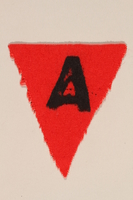
Unused red triangle concentration camp patch with an A found by US military aid worker
Object
Unused, red inverted triangle badge with the letter A found by Lt. Milton Shurr, a Jewish American soldier, in April-May 1945 at the recently liberated Buchenwald concentration camp in Germany. The red cloth was to identify the inmate as a political prisoner. The letter indicated camp status or nationality. The patch would be attached on the left breast of the jacket or on the pants leg. First Lt. Shurr assisted in the planning for D-Day, June 6, 1944, and joined the Civil Affairs Unit. He landed on Omaha Beach soon after the invasion to organize medical supplies. He was placed with the 1st Army Displaced Persons Team. On April 11, 1945, the US Third Army liberated Buchenwald. Command of the camp was transferred to the 1st Army, which was responsible for establishing order, improving camp conditions, and caring for the inmates. Shurr worked 16 hour days trying to find enough food for the 15,000 starving survivors at the camp. He was a liaison with the Red Cross and American Jewish Joint Distribution Committee. He later was sent to Bavaria as a health welfare officer to assist with the re-establishment of schools, hospitals, and other social services by the US Military occupation government.
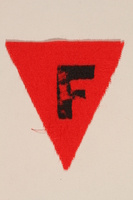
Unused red triangle concentration camp patch with an F found by a US military aid worker
Object
Unused, red inverted triangle badge with the letter F found by Lt. Milton Shurr, a Jewish American soldier, in April-May 1945 at the recently liberated Buchenwald concentration camp in Germany. The red cloth was to identify the inmate as a political prisoner. The letter indicated camp status or nationality. F could be for French [Franzosischer.] The patch would be attached on the left breast of the jacket or on the pants leg. First Lt. Shurr assisted in the planning for D-Day, June 6, 1944, and joined the Civil Affairs Unit. He landed on Omaha Beach soon after the invasion to organize medical supplies. He was placed with the 1st Army Displaced Persons Team. On April 11, 1945, the US Third Army liberated Buchenwald. Command of the camp was transferred to the 1st Army, which was responsible for establishing order, improving camp conditions, and caring for the inmates. Shurr worked 16 hour days trying to find enough food for the 15,000 starving survivors at the camp. He was a liaison with the Red Cross and American Jewish Joint Distribution Committee. He later was sent to Bavaria as a health welfare officer to assist with the re-establishment of schools, hospitals, and other social services by the US Military occupation government.
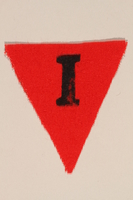
Unused red triangle concentration camp patch with an I found by a US military aid worker
Object
Unused, red inverted triangle badge with the letter I found by Lt. Milton Shurr, a Jewish American soldier, in April-May 1945 at the recently liberated Buchenwald concentration camp in Germany. The red cloth was to identify the inmate as a political prisoner. The letter indicated camp status or nationality. I is likely for Italian. The patch would be attached on the left breast of the jacket or on the pants leg. First Lt. Shurr assisted in the planning for D-Day, June 6, 1944, and joined the Civil Affairs Unit. He landed on Omaha Beach soon after the invasion to organize medical supplies. He was placed with the 1st Army Displaced Persons Team. On April 11, 1945, the US Third Army liberated Buchenwald. Command of the camp was transferred to the 1st Army, which was responsible for establishing order, improving camp conditions, and caring for the inmates. Shurr worked 16 hour days trying to find enough food for the 15,000 starving survivors at the camp. He was a liaison with the Red Cross and American Jewish Joint Distribution Committee. He later was sent to Bavaria as a health welfare officer to assist with the re-establishment of schools, hospitals, and other social services by the US Military occupation government.
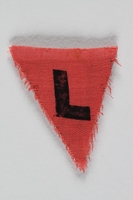
Unused red triangle concentration camp patch with an L found by a US military aid worker
Object
Unused, red inverted triangle badge with the letter L found by Lt. Milton Shurr, a Jewish American soldier, in April-May 1945 at the recently liberated Buchenwald concentration camp in Germany. The red cloth was to identify the inmate as a political prisoner. The letter indicated camp status or nationality. The patch would be attached on the left breast of the jacket or on the pants leg. First Lt. Shurr assisted in the planning for D-Day, June 6, 1944, and joined the Civil Affairs Unit. He landed on Omaha Beach soon after the invasion to organize medical supplies. He was placed with the 1st Army Displaced Persons Team. On April 11, 1945, the US Third Army liberated Buchenwald. Command of the camp was transferred to the 1st Army, which was responsible for establishing order, improving camp conditions, and caring for the inmates. Shurr worked 16 hour days trying to find enough food for the 15,000 starving survivors at the camp. He was a liaison with the Red Cross and American Jewish Joint Distribution Committee. He later was sent to Bavaria as a health welfare officer to assist with the re-establishment of schools, hospitals, and other social services by the US Military occupation government.
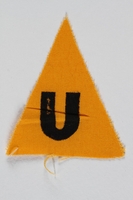
Unused yellow triangle concentration camp patch with a U found by a US military aid worker
Object
Unused, yellow triangle badge with a black letter U found by Lt. Milton Shurr, a Jewish American soldier, in April-June 1945 at the recently liberated Buchenwald concentration camp. The yellow cloth would mark the inmate as Jewish. The letter indicated camp status or nationality. The letter U could be for Ungarisch (Hungarian]. Patches were usually applied with the triangle inverted, or point down. However, there were combination badges: 2 overlapped triangles, 1 upright, 1 inverted, formed a Judenstern or Star of David. Or a yellow triangle might be placed over a black triangle to identify a non-Jewish person, usually female, who had sex with a Jew. The patch would be attached on the left breast of the jacket or on the pants leg. First Lt. Shurr assisted in the planning for D-Day, June 6, 1944, and joined the Civil Affairs Unit. He landed on Omaha Beach soon after the invasion to organize medical supplies, then was placed with the 1st Army Displaced Persons Team. On April 11, 1945, the US Third Army liberated Buchenwald. Command of the camp was transferred to the 1st Army, which was responsible for establishing order and caring for the inmates. Shurr worked 16 hour days trying to find enough food for 15,000 starving survivors. He later was sent to Bavaria as a health welfare officer to assist with the re-establishment of schools, hospitals, and other social services by the US Military occupation government.
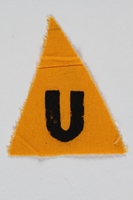
Unused yellow triangle concentration camp patch with a U found by a US military aid worker
Object
Unused, yellow triangle badge with a black letter U found by Lt. Milton Shurr, a Jewish American soldier, in April-June 1945 at the recently liberated Buchenwald concentration camp. The yellow cloth would mark the inmate as Jewish. The letter indicated camp status or nationality. The letter U could be for Ungarisch (Hungarian]. Patches were usually applied with the triangle inverted, or point down. However, there were combination badges: 2 overlapped triangles, 1 upright, 1 inverted, formed a Judenstern or Star of David. Or a yellow triangle might be placed over a black triangle to identify a non-Jewish person, usually female, who had sex with a Jew. The patch would be attached on the left breast of the jacket or on the pants leg. First Lt. Shurr assisted in the planning for D-Day, June 6, 1944, and joined the Civil Affairs Unit. He landed on Omaha Beach soon after the invasion to organize medical supplies, then was placed with the 1st Army Displaced Persons Team. On April 11, 1945, the US Third Army liberated Buchenwald. Command of the camp was transferred to the 1st Army, which was responsible for establishing order and caring for the inmates. Shurr worked 16 hour days trying to find enough food for 15,000 starving survivors. He later was sent to Bavaria as a health welfare officer to assist with the re-establishment of schools, hospitals, and other social services by the US Military occupation government.
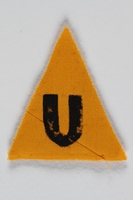
Unused yellow triangle concentration camp patch with a U found by a US military aid worker
Object
Unused, yellow triangle badge with a black letter U found by Lt. Milton Shurr, a Jewish American soldier, in April-June 1945 at the recently liberated Buchenwald concentration camp. The yellow cloth would mark the inmate as Jewish. The letter indicated camp status or nationality. The letter U could be for Ungarisch (Hungarian]. Patches were usually applied with the triangle inverted, or point down. However, there were combination badges: 2 overlapped triangles, 1 upright, 1 inverted, formed a Judenstern or Star of David. Or a yellow triangle might be placed over a black triangle to identify a non-Jewish person, usually female, who had sex with a Jew. The patch would be attached on the left breast of the jacket or on the pants leg. First Lt. Shurr assisted in the planning for D-Day, June 6, 1944, and joined the Civil Affairs Unit. He landed on Omaha Beach soon after the invasion to organize medical supplies, then was placed with the 1st Army Displaced Persons Team. On April 11, 1945, the US Third Army liberated Buchenwald. Command of the camp was transferred to the 1st Army, which was responsible for establishing order and caring for the inmates. Shurr worked 16 hour days trying to find enough food for 15,000 starving survivors. He later was sent to Bavaria as a health welfare officer to assist with the re-establishment of schools, hospitals, and other social services by the US Military occupation government. In 1949, he declined a permanent position and returned to the US.
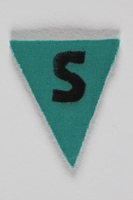
Unused green triangle concentration camp patch with an S found by a US military aid worker
Object
Green inverted triangle badge with a black letter S found by Lt. Milton Shurr, a Jewish American soldier, in April-May 1945 at the recently liberated Buchenwald concentration camp in Germany. The green cloth would identify a convicted criminal. The letter would signify camp status or nationality. S is likely for Sicherungsverwahrte [Preventive Custody), a term often used by the SS to hold indefinitely a person who had completed their prison sentence, but whom the SS considered socially undesirable and not fit to be released into German society. It was often used to keep homosexuals from being released from prison, but it was flexible and could be applied any person charged with an offense. The triangle would be attached on the left breast of the jacket or on the pants leg. Shurr assisted in planning for D-Day, June 6, 1944, and joined the Civil Affairs Unit. He landed on Omaha Beach soon after the invasion. He was placed with the 1st Army Displaced Persons Team. On April 11, 1945, the US Third Army liberated Buchenwald. Command of the camp was transferred to the 1st Army, which was responsible for establishing order and caring for the inmates. Shurr worked 16 hour days trying to find enough food for 15,000 starving survivors. He was a liaison with the Red Cross and American Jewish Joint Distribution Committee. He later was sent to Bavaria as a health welfare officer to assist with the re-establishment of schools, hospitals, and other social services by the US Military occupation government.
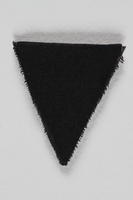
Unused black triangle concentration camp patch found by a US military aid worker
Object
Unused, blank black triangle patch found by Lt. Milton Shurr, a Jewish American soldier, in April-May 1945 at the recently liberated Buchenwald concentration camp in Germany. The black cloth signified that the inmate was classed as asocial, a term used for those considered too deviant, lazy, or selfish to contribute to society. This flexible category could include addicts and alcoholics, the disabled, homeless, homosexuals, pacifists, or Roma. The patch would be attached on the left breast of the jacket or on the pants leg. First Lt. Shurr assisted in the planning for D-Day, June 6, 1944, and joined the Civil Affairs Unit. He landed on Omaha Beach soon after the invasion to organize medical supplies. He was placed with the 1st Army Displaced Persons Team. On April 11, 1945, the US Third Army liberated Buchenwald. Command of the camp was transferred to the 1st Army, which was responsible for establishing order, improving camp conditions, and caring for the inmates. Shurr worked 16 hour days trying to find enough food for the 15,000 starving survivors at the camp. He was a liaison with the Red Cross and American Jewish Joint Distribution Committee. He later was sent to Bavaria as a health welfare officer to assist with the re-establishment of schools, hospitals, and other social services by the US Military occupation government.
Unused yellow triangle concentration camp patch with a U found by a US military aid worker
Object
Unused, yellow triangle badge with a black letter U found by Lt. Milton Shurr, a Jewish American soldier, in April-June 1945 at the recently liberated Buchenwald concentration camp. The yellow cloth would mark the inmate as Jewish. The letter indicated camp status or nationality. The letter U could be for Ungarisch (Hungarian]. Patches were usually applied with the triangle inverted, or point down. However, there were combination badges: 2 overlapped triangles, 1 upright, 1 inverted, formed a Judenstern or Star of David. Or a yellow triangle might be placed over a black triangle to identify a non-Jewish person, usually female, who had sex with a Jew. The patch would be attached on the left breast of the jacket or on the pants leg. First Lt. Shurr assisted in the planning for D-Day, June 6, 1944, and joined the Civil Affairs Unit. He landed on Omaha Beach soon after the invasion to organize medical supplies, then was placed with the 1st Army Displaced Persons Team. On April 11, 1945, the US Third Army liberated Buchenwald. Command of the camp was transferred to the 1st Army, which was responsible for establishing order and caring for the inmates. Shurr worked 16 hour days trying to find enough food for 15,000 starving survivors. He later was sent to Bavaria as a health welfare officer to assist with the re-establishment of schools, hospitals, and other social services by the US Military occupation government.



